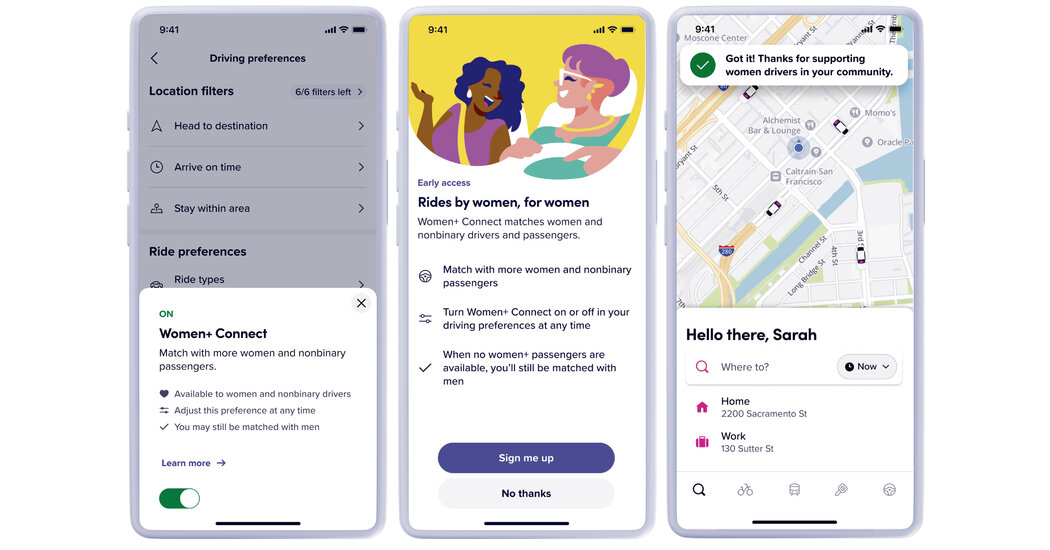Instacart Was All About Grocery Delivery. No Longer.
When Fidji Simo took over as chief executive of Instacart in 2021, the grocery delivery start-up’s growth was cratering as its pandemic boom ebbed. The board of directors asked her to find new ways for the company to earn money.
Ms. Simo, a former executive at Meta with experience in advertising, played to her strengths. She aggressively expanded Instacart’s advertising business, begun in 2019, which allows food brands to pay for better placement in the company’s app. Brands had questioned whether the ads were helping, so Ms. Simo commissioned studies demonstrating their efficacy, two people familiar with the company said.
She also hatched a plan to sell software tools and other products to grocery companies to help improve shopping experiences, they said. Then she embarked on a good-will tour to visit the grocery companies and hosted their executives at her home in Carmel, Calif.
As Instacart prepares to go public next week, it is a markedly different company. Envisioned in 2012 as a service that matched people at home with contract workers who would shop for them and deliver groceries, it has increasingly focused on advertising and software products as its delivery business has slowed.
Last month, Instacart revealed in an offering prospectus that the ads and software sales had allowed it to do what skeptics considered impossible — turn a profit. Other so-called gig economy companies that use contract workers to deliver goods via apps have typically failed to do so.
Nearly a third of Instacart’s $2.5 billion in revenue last year came from its “highly profitable” ads and software division, according to its prospectus. In the first half of this year, Instacart’s $406 million in revenue from ads and software helped propel it to $242 million in profit.
Instacart shows that one way for a historically unprofitable gig business to get to the public markets is to diversify into more lucrative areas and move away from its gig-economy roots. It has been a long road for the start-up, which weathered years of losing money and the 2021 resignation of its co-founder and former chief executive, Apoorva Mehta, after friction with the board.
Still, Instacart’s profits may not be enough to attract investors to its I.P.O. Once worth $39 billion in the private markets, the company has slashed its valuation several times, most recently to $10 billion. In a filing this week, it set a price range of $26 to $28 a share, valuing it at $8.9 billion at the midpoint. Instacart plans to list its shares on the Nasdaq stock exchange, days after the public offering of Arm, the British chip designer.
In an interview last year, Ms. Simo, who is now 37, said she was overseeing a “third act of the company” — after first attracting consumers and then attracting grocers — which included the software tools for retailers. She said her goal was for Instacart to compete more with Amazon, which offers grocery delivery services, and to help grocery stores adapt to the digital world.
“It really shows very clearly where we’re going as a company and this new ambition,” Ms. Simo said.
Instacart declined to comment, citing a quiet period before its I.P.O. Meredith Kopit Levien, The New York Times’s chief executive, sits on Instacart’s board.
From its founding in 2012, Instacart burned through cash, like other companies at the time that jumped on the proliferation of smartphones and cloud computing to offer real-world services via apps. At the tap of a button, these apps conjured up services including dog walking, housecleaning, takeout and taxi rides.
Investors ate them up, betting the companies would grow large enough to generate profits. But even though consumers loved the apps’ convenience, they scoffed at high fees. Many of the companies went under or sold. The most successful — Uber, Lyft and DoorDash — have never turned an annual profit.
Mr. Mehta, Instacart’s co-founder, had plans to change that. A former engineer at Amazon, he determined early on that Instacart could build a business promoting products to its customers using the data it collected on their grocery purchases, just as Amazon had.
“The belief was if we reached enough scale, there would be an interesting advertising business to be built,” said Ali Rowghani, an investor in Instacart.
When Instacart started selling ads four years ago, its executives debated whether they would turn off customers, a person familiar with the conversations said. After internal tests showed that the impact was minimal, the company increased the types and frequency of ads shown.
Ms. Simo took over Instacart during a volatile period. The company had benefited from the pandemic when people stuck at home ordered groceries through the app, sending its grocery sales soaring 303 percent in 2020. Growth continued into 2021 but slowed to 20 percent overall that year as people returned to shopping in person in stores.
Ihar Mahaniok, an investor at Geek Ventures who provided funding to Instacart in 2012, said the start-up’s potential had excited him but that he had worried about its ability to make money. He was encouraged by Ms. Simo’s appointment, he said, because he had worked on her team at Meta and had seen firsthand how she balanced innovative ideas with efficiency.
“I really trusted she’d be able to figure this out, and she did,” he said.
Ms. Simo strengthened the advertising business by adding more than a dozen tools, including video ads and pop-ups. She also introduced Instacart Platform, the software offerings for grocery companies.
Ms. Simo had pitched working more closely with grocery retailers to Instacart’s board before she started the job. She suggested that the company buy start-ups like Caper, which makes an electronic shopping cart that helps customers check off their grocery lists and lets retailers track their purchases, a person with knowledge of the conversations said. Instacart bought Caper in October 2021 for $350 million.
Grocers had long worried that Instacart would compete with them, but Ms. Simo emphasized that the company wanted to be a partner rather than a rival, retailers said.
“She is very powerful at affirming that message and has been very consistent in her actions over the past couple years,” said Neil Stern, the chief executive of Good Food Holdings, which operates several regional grocery chains. He became an early tester of Instacart Platform after a series of Zoom meetings with Ms. Simo in the summer of 2021.
Instacart still faces challenges. The company relies heavily on a few large grocery retailers like Kroger and Costco for orders, leaving it vulnerable if one of those chains switched to a competitor.
Its grocery delivery business has also stagnated. In its prospectus, Instacart said grocery orders last year rose 18 percent, but that orders in the first half of this year were flat compared with a year earlier. That sluggishness could hamper its lucrative ads business if there are not enough delivery customers to show the ads to.
“The ads business only works because you have the core delivery business,” said Nikhil Devnani, an analyst at Bernstein. “They’re part and parcel with each other.”


